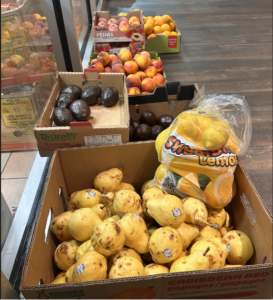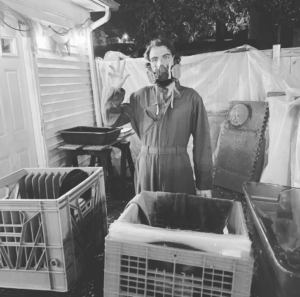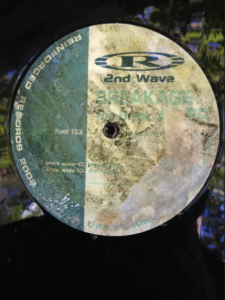By Asia McGill
It didn’t rain in Papua New Guinea for most of 1997.
Surekha Sridhar was a child during the drought. The tap water ran for just two hours every other day, she said, and the reservoirs had gone so shallow that the water supply was brown. The sun’s relentless blaze prematurely aged the produce that grew on the land.
“When you grow up in a tropical environment… everything ripens so quickly,” Sridhar said. “So you start to learn about what’s good, what’s not so good, what’s edible, what’s not edible.”
Sridhar learned that food can be useful beyond its expiration. She knew if her milk curdled, it could be aged into cheese. Produce could be fermented or pickled to last for months. The bad corner of the bread could be chopped off.
When she moved to New Zealand to pursue a degree in geography, she saw less of a shared conviction to make the most out of every meal and said she was surprised to see how many people were “removed from the food process.”
“A lot of New Zealand children think milk comes from the supermarket, not cows,” she said.
When Sridhar came to America later in her career as an environmentalist, she was no longer shocked that consumers threw a lot of their food away, but couldn’t believe how often processed food was trashed. Food that’s formulated to last longer doesn’t even stand a chance.
The U.S., including D.C., has a much-debated trash problem, from food waste to single-use plastics and fast fashion. And study after study has documented the impact — some showing it’s worse than we believe. In a May 2024 report, researchers at the Harvard John A. Paulson School of Engineering and Applied Sciences found the Environmental Protection Agency is underestimating methane emissions from landfills and urban areas — an important measure to keep track of and try to improve, authors note, because methane is the second largest contributor to climate change.
Video by Asia McGill
As part of the Sustainable DC plan, released in 2013, the district has a goal of becoming the “healthiest, greenest [and] most livable city in the United States by 2032.” The city now has seven years left to reach 80% citywide waste diversion — at the halfway point, it was at 27.9%, according to a 2024 progress report. Programs touted in the report include more accessible battery recycling, curbside composting, grants for deconstruction and salvage, and community repair or FixIt events. Maryland similarly has a voluntary waste diversion goal of 60%, and in 2021, the state legislature passed a law requiring entities like schools, grocery and convenience stores to separate food waste from trash headed for landfills and incinerators.
Virginia has lagged somewhat behind. Earlier this month, Virginia state House members proposed a bill to prohibit grocery stores from selling or distributing plastic bags (D.C. passed the first of its kind in 2009), and another to create an annual zero waste awareness week.
Waste elimination advocates of the DMV have found creative and unique approaches to sustainability outside of government initiatives. Still, it can be daunting. There’s simply too much trash.
Reston Strong is a food rescue organization in Reston, Virginia, staffed with a group of volunteers that save rejected groceries from the doom of landfills.
Sridhar volunteers at Reston Strong as part of their sustainability team, salvaging around 50 pounds of food for their open market, and sending close to 200 pounds of food waste to be composted on a weekly basis.

Sridhar admits that while the work she does fulfills her, there’s only so much rescuing one organization can do.
“The part of it that still is disheartening is to see the volume of food that comes in that we’re still not able to salvage, and knowing that there are other supermarkets and grocery stores out there that essentially is still going to trash anything that’s now deemed no longer shelfable and sellable,” she said.
The nation’s capital experiences high volumes of food waste – a report by Compost Crew found that D.C. averaged 414 tons of food waste last year. Part of the excess food stems from the city’s bars, caterers and nightclubs.
D.C. Central Kitchen has operated for 35 years to recover food loss from social hubs around the city. Food donated by establishments are reconstructed into new meals and supplied to homeless shelters, rehabilitation clinics, and after-school programs.
“Sometimes you don’t necessarily know what’s gonna be coming through your door, it could be a mixed match of items and not necessarily the fresh fruits and vegetables,” said Jackie Wincek, the procurement and sustainability manager at D.C. Central Kitchen.
Even with 2.4 million meals prepared in 2023, D.C. Central Kitchen isn’t able to accept every donation – a situation that Wincek admits can create tension, internally and externally.
“We have limited resources and we need to be smart about how we’re using them,” Wincek said. “We have only so much space that we’re able to bring things on site.”
Wincek describes food loss as a “frustrating simple problem,” but is optimistic that other people are beginning to care more about finding a solution.
“I think that there’s a lot of other people who feel just as passionate, but it’s pressing that we do it as soon as possible,” she said.
Food that is being thrown away goes further than just households, nightclubs and restaurants.
It’s in the elementary schools too.
Melissa Adams is a 4th grade teacher at Canterbury Woods Elementary School in Annandale, Virginia. In her 29 years of teaching, she said she’s seen no reduction in food waste. In addition to the main course, students are required to have a fruit, vegetable and milk on their tray.
“Maybe the kids don’t want milk. They have to have milk, so it gets thrown away and it’s an incredible amount of food that kids might not want,” Adams said.
The cafeteria workers can’t stop the waste before it happens either, Adams says, they are just “going by the rules” when plating each lunch tray.
As part of Get2Green, a Fairfax County environmental program, Adams encourages students to place the items they don’t want on a “share table” in the cafeteria. Almost like an exchange system, students can grab items they want on the table and also leave items they don’t.
But that system hasn’t been full-proof, because at times what is left on the share table at the end of lunch still ends up in the trash.
Adams heard about other elementary schools trying to donate their excess food supply, but they haven’t found much help either.
“I know that there are some schools that were delivering their food to people who were feeding [the] homeless. I don’t know the organization, but they said there’s so much food coming from the elementary schools that they don’t have enough space for it,” she said
The burden of wasted food weighs heavily on faculty. Lunchroom monitors try to rehouse fresh fruit to the teacher’s lounge, but it’s too much for the teachers, too. Adams remembers a time seeing about 40 to 50 apples brought back by one of the monitors.
“I’m working 10-12 hours a day. I don’t have time to drive to a food shelter,” she said. “It’s a burden on the teachers. No one from the county is coming in to say: ‘Here’s some possible solutions.’”
The school has attempted to partner with food rescue organizations, but they can’t take on the capacity of it, either. There is just too much food.
Adams attended the screening of a food waste documentary in September at a Fairfax cinema theater. After the screening, an open discussion began with four panelists from different professional backgrounds of waste and sustainability. When organizers opened the conversation to the audience, Adams asked if anyone could help her with the food waste issue at her school.
The co-founder and executive director at Reston Strong offered their services.
“My principal was so ecstatic,” Adams said, that “we’re finding community members to help us solve the problem because we can’t do it by ourselves.”
Really, part of the solution for food waste may mean changing America’s waste system entirely.
Matthew Adams works with Fairfax County government and is responsible for enforcing codes around trash and its collection. He and his team are working on a strategy that proposes a new way to light a fire under residents that produce excessive amounts of trash.
They call it “pay as you throw.” Citizens and businesses would purchase trash bins that match the amount of waste they’re producing.
“The big goal is to divert as much material to reduce or minimize the amount of waste that we’re throwing away and incentivizing individuals to, you know, be more mindful and manage their waste more appropriately,” he said.
For businesses that typically toss higher levels of trash, they would purchase a 95 gallon trash cart, for example. For someone like Matthew Adams who only has one trash bag every two weeks, something like a 20 gallon trash can would be more suitable for his waste contributions.
Instead of just separating recyclables from trash, Matthew Adams sorts it even further: He donates glass to the Purple Glass Recycling Container, organic waste to a local composter, and old clothes to a Goodwill. He knows this isn’t an ideal practice for everyone’s schedules or routines, but as he describes it, “that way I know it’s being recycled. I guarantee you it’s going to the recycling. It’s going to be used again.”
Matthew Adams also works to educate the public on what can be recycled and the sorts of programs they can use to separate their trash further like he does.
“If every person in Fairfax County, just one time, removed one bottle and put it in a plastic bin or like didn’t buy something, or reduce their impact on the environment, or… composted… just one time. That’s a million bottles,” he said.
Even though many solutions to America’s waste issue tend to point the finger to consumers, Georgia Kerkezis, a climate change and sustainability specialist at ICF, a global advisory and tech consulting firm, says the blame cannot be pinned there entirely. And it’s not just food that is being wasted. It’s practically everything we use.
Kerkezis notes that corporations often produce goods with cheap materials. Nowadays items are “simply not built to last,” she says. This leads customers to be sucked into the endless cycle of ‘out with the old and in with the new.’
Compare that, Kerkezis said, to grandparents who own the same appliances they did decades ago. The old-school washing machines may clamor a bit, but they still wash each load. The 30-year-old refrigerator probably hums when it’s opened, but it keeps food cold. “It still works to this day,” Kerkezis said. “Like it’s going to work for hundreds of years.”
While there’s not much a consumer can do about what they buy wearing down quickly, Kerkezis suggests corporations should collaborate with customers more often to tackle material waste through refurbishment or buyback programs.
A few corporations do something like this already, like Target’s offer to customers to return Cat and Jack kid’s clothing a year after purchase in exchange for cash. Or IKEA’s buyback and reselling program for old, but good furniture.
Programs like this are not offered on a large enough scale, Kerkezis said. So in the meantime, items will continue to be tossed to the curb, thrown in a dumpster, and transported to a landfill abyss.
Although, the dumpster is not always a closed chapter. For some, it’s a chance to be born again.

It was the beginning of COVID-19 when Ocean Elier slid a face mask on before his operation, unsure if anyone had ever been successful in such a procedure. He couldn’t rely on Youtube tutorials or purchase any specific equipment to aid him in his performance, and he didn’t have just one patient.
He had 600.
Elier practiced fixing random items through his life-long practice of dumpster diving, but had never come across a repair like this.
Elier was born in the late ‘70s and grew up in Athens, Ohio – a town where the motto “reduce, reuse, and recycle” was taken as more of a challenge than a suggestion.
Athens was the kind of town where a dumpster stood as some sort of purgatory for trash, where it was either condemned to the garbage underworld or rescued by the saving hand of a dumpster diver.
After years of finding items from the trash and refurbishing them, Elier became handy. Some items needed minor repairs like reshaping and mending a chip on a skateboard or replacing the rubber bands on an NPR tape deck that took 30 minutes of tinkering and tweaking.
But 600 damaged vinyl records was not a quick repair.

He began the procedure outside of his home by running a bath in a plastic bin filled with water and Dawn dish soap, plunging the records to give them their first soak. The soap slowly etched away the filthy coating. Elier couldn’t hang the records to dry in his unacclimatized shed because the vinyl would warp, so he hand-dried each disc with a microfiber towel.
He ran another bath, this time with water and bleach. The records went for another soak.
He revs up his pressure washer, with all of the records held in a frame to be able to withstand the force of the water. He doesn’t know if the records can handle the level of water pressure he is applying.
By this point, the water liquified the glue from its labeling, requiring Elier to move with more precision and speed. He dips them in a bleach bath once again.
This process repeats until he is satisfied with the appearance of each record.
The discs are blasted with water as a final rinse.
They’re dried off with an air compressor and given another wipe down with a microfiber towel.
But he was left with another problem. All of the labels on the vinyl records were blasted off by the pressure washer, leaving hundreds of miscellaneous records to sort and relabel.
With the help of social media, Elier live streamed himself playing each record to social followers.
Elier was a live DJ on the side, so his fanbase quickly became invested in all of the record’s origins. Once all of the records were identified and labeled, Elier could finally resleeve each vinyl with its new protective packaging.
Three years later, all 600 records were recovered, with music within them that never perished.















Add comment